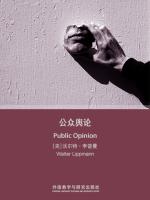A book review on Public Opinio
Chaotic and complex social lives shatter our naive assumptions about public opinion. This is the core of Walter Lippmann’s great work, Public Opinion, published in 1922. Started with Plato’s metaphor of the cave and ended with Time, it demonstrated a panoramic view of public opinions that serves as a profound foundation of later studies of communication.
Part I, the Introduction, may be interpreted via the triple (Place A, Pseudo-environment, Place B). Residing in Place A, we form a pseudo-environment about B, but act on B with real power, which gives rise to the following problems: the degree of fidelity between B and the pseudo-environment, and the mechanism of news from B stimulating Place A.
The communication process may be broken as follows: source of information, interpretation, receiver, and decision according to the pictures—defined as Public Opinions. Part II mainly concerns the source and the receiver. At the source of information, censorship filters and rearranges the data as well as preventing independent access, to ensure the ‘needed fact’. As for receivers, words may be distorted and refracted in various occasions, especially when thoughts were carried out in a flattened bath of noise, along with time and attention so limited and varied.
Chapter 3 in Part II, giving a powerful treatment of social sets, bears an intimate bond to Part III: Stereotype. Social sets, with their chaotic varieties, contribute to a confusing pattern of information circulation. In particular, the leaders of the sets occupy special access to other sets and are imitated by the inferior. The social sets sanction information with their implanted canons, which may be equated with stereotypes. Overgeneralising and inherited, stereotypes are the backgrounds of our judgement, the foundation of our universe, where we feel at home, safe and snug, the ‘Umwelt’ as Heidegger describes. Ideas may be interpreted with their original meanings corrupted, like Marxism that is ‘claimed’ to be faith in various countries, used as ideology to inspire ‘religious duty’. Codes and expertise like the simplification in economics may be taken as complete reality instead of mere one-sided interpretations. Conspiracy theory is yet another kind of stereotype.
Part IV switches from stereotypes in groups to personal interests. To express something, we usually visualise it with our personal interests, projecting my experience on it like shutters and lenses. Our interests may also be the sheer joy of participation rather than the essence of the problem, ‘cluttering without understanding’, as Heidegger may say.
Part V and VI deals with political practices related with public opinions. The authorities, attaching more importance to action instead of truth and contemplation, manufacture consent by using symbols and ‘ultimate purposes’ like ‘American mind’ to create an aura of suggestion, remain cloudy on controversies and select the topic fitting everyone, stressing unity, to endow you with a self-determined mind-set, which manifests sarcasm to the presupposition of ‘self-sufficient individuals’ by the democrats.
Part VII focuses on newspapers. First, reporters are not perfect and rely heavily on recording institutions. Second, the low price of newspapers determines its intrinsic pursuit in circulation, for advertisement constitutes its major income. Therefore, editors must cater to the taste of readers, whose loyalty and interests can still vary.
At last, the author suggests setting up intelligence bureaus that compete and cooperate, the separation between investigators and executives, quantitative measures and dialectics between the parties involved and the experts.
To conclude, the author principally means to challenge the abstract, idealised concept of ‘public opinion’ based on unfounded assumptions like ‘normal environment’ ’free from conventions’ ‘pre-established harmony’, by presenting the vast number of variables in communication which indicate its chaotic behaviours.
I appreciate the author’s attitude to explore, to confront the complex lives bravely instead of retreating to assumptions and simplification. However, the work is far from ‘assumption-free’. The author bears superstition in ‘real environment’ and ration. The author still assume the existence of a ‘real’ environment independent of interpretations, but the reality, in fact, has always been viewed against a particular background—therefore, the pseudo-environment conveys part of truth not found in the ‘real environment’, as the shadows of Plato’s cave constitute a particular side of the shapes not viewed by the residents above. What the author means by ‘real environment’ is the ‘closer’ environment, which is certainly distinct from the standard of reality, for we may even understand something better as outsiders. Our world has always been interpreted, and our job is running through various editions and creating the best one instead of assuming one beforehand. As for ration, the contempt shown for emotion and belief for expertise permeated the whole work without proof, especially in the naive solution given by the author at last, which is unacceptable. The author should also prove that his work is beyond stereotypes, or it will suffer from self-contradiction.
The author also provides inspiring insights into humanity, coinciding with many ideas of Heidegger. As for style, detailed examples other than doctrines feature prominently, leaving enough room for the readers’ judgement though it may sacrifice the rigour of the global structure.
To conclude, despite various limitations, the Public Opinion remain a great work that can alter your thinking pattern to a tremendous degree and definitely worthwhile to read.



 京公网安备 11010802032529号
京公网安备 11010802032529号